India’s Trade and Economic Partnership Agreement (TEPA) with the European Free Trade Association (EFTA) came into force on 1 October 2025. For the life sciences community, the pact is more than a tariff play: it reshapes market access, intellectual property calculus, and registration logistics on both sides of the route linking Switzerland—the innovation hub for medicines and devices—and India—the world’s largest supplier of generics and an increasingly sophisticated MedTech manufacturer. This post explores where the fresh openings lie, where caution is warranted, and how Swiss and Indian firms can position themselves to capture the post-TEPA upside. It does not dive into exhaustive regulatory minutiae; instead, it offers an executive guide for commercial and compliance teams planning their next move.
The backdrop: Why TEPA matters
Before TEPA, bilateral trade in pharmaceuticals and medical technology was already vibrant, yet tariff walls and procedural frictions left money on the table. TEPA phases out Indian duties—previously as high as 13.75%—on roughly 80–85% of EFTA goods, including most finished drugs, active pharmaceutical ingredients (APIs), diagnostics, and high-end devices. On the Swiss side, tariffs on Indian products were already low, but the agreement locks in certainty and references World Trade Organization (WTO) norms for intellectual property while leaving room for domestic policy on public health and generics. Added to this is an EFTA commitment to channel at least USD 100 billion of investment into India over fifteen years, making TEPA a strategic, not merely fiscal, instrument.
Opportunities for Swiss pharma and MedTech companies in India
Price competitiveness through tariff elimination
Tariff cuts cascade directly into landed cost. A high-precision orthopaedic implant that faced a 7.5% basic customs duty (plus assorted cesses) can now enter at—or close to—zero, flattening price negotiations with hospitals and boosting Swiss bids in public tenders.
Access to a rapidly expanding patient base
India’s healthcare spending is rising at double-digit rates, driven by chronic disease prevalence, insurance penetration, and a digital-health push. Premium urban tertiary hospitals increasingly adopt global quality benchmarks; they constitute natural entry points for Swiss specialty devices, biologics, and orphan drugs.
Investment and partnership facilitation
TEPA’s investment chapter goes beyond classic “protection” language. India undertakes to “endeavour to ensure a favourable climate for foreign direct investment” and to cooperate on problem-solving if perceived investment targets are not met. Combined with domestic production-linked incentive (PLI) schemes, Swiss innovators can co-invest with Indian contract manufacturers, share technology without mandatory transfer requirements, and localise packaging or final-stage formulation to optimise price controls.
Regulatory dialogue
While TEPA does not rewrite India’s Drugs and Cosmetics Act, it establishes standing committees to discuss technical-barrier and sanitary-phytosanitary issues. For Swiss dossiers, this opens a formal channel to streamline data-requirement clarifications, navigate language on risk assessment, and accelerate time to market.
Risk matrix for Swiss originators, generics and device makers
Intellectual property constraints
India’s patent regime, anchored to TRIPS but shaped by the famous Section 3(d) bar on “evergreening”, remains restrictive. TEPA explicitly preserves the Doha Declaration on Public Health; there is no data exclusivity period or patent-term extension. Originator biologics therefore face earlier biosimilar challenge timelines than in the EU or US. Generic divisions of Swiss multinationals, by contrast, see opportunity—but must still pass the scrutiny of India’s patent-opposition culture, which includes pre-grant challenges and civil-society activism.
“Swiss made” label sensitivities
Indian regulations do not run a dedicated “country of origin” enforcement regime for medical products, yet mislabelling can trigger Customs or consumer-protection action. TEPA’s trademark provisions bar registration of country names that mislead on origin. Swiss firms should police distributors vigilantly: if an Indian partner overemphasises “Swiss precision” on locally assembled products, competitors—or regulators—may allege deceptive origin claims.
Pricing and procurement pressures
Essential medicines fall under India’s National List of Essential Medicines (NLEM) price cap. Even non-NLEM products increasingly encounter aggressive tender pricing in government schemes. Devices are moving in the same direction, with cardiac stents and orthopaedic knee implants already under price ceilings. Swiss suppliers must model realistic net realisation scenarios.
Regulatory timelines and local-trial triggers
The Central Drugs Standard Control Organization (CDSCO) reserves discretion to demand local Phase III bridging data for drugs not marketed in specified reference countries. Although Switzerland is an International Council for Harmonisation (ICH) member, the CDSCO may still require limited Indian cohort data for novel biologics, extending timelines by six to twelve months. On the device front, India’s risk-based framework (Class A–D) mandates import licences and local post-market surveillance that can challenge smaller Swiss innovators unused to high-volume vigilance reporting.
Opportunities for Indian pharma and MedTech companies in Switzerland
Duty-free entry and high-value price bands
Swiss tariffs on most pharmaceuticals, APIs, and finished devices are negligible, but TEPA locks this in and provides legal predictability. For Indian exporters, access to a premium payer market offers margin upside even after complying with Switzerland’s stringent quality documentation.
Mutual recognition of conformity discussions
Switzerland’s schedule of specific commitments references future cooperation on technical regulations and conformity-assessment procedures. If the dialogue leads to partial recognition of Indian notified bodies—or at least streamlined Swissmedic and Swissmedic-equivalent audits—Indian device makers could shorten their Swiss go-to-market pipeline.
Brand visibility and co-development
Indian companies can leverage Switzerland’s reputation for quality by co-developing biosimilars and complex generics with Swiss SMEs that own niche technologies but lack cost-efficient scale. TEPA’s services chapter grants Indian R&D outfits national-treatment status for cross-border contract research, encouraging clinical-data generation in Switzerland.
How Swiss products are registered in India
Pharmaceuticals
All new drugs, biologics, and vaccines require CDSCO approval. Swiss manufacturers must:
- Appoint an authorised Indian agent or subsidiary.
- Submit Form CT-04 with Common Technical Document (CTD) modules, stability data across climatic zone IVb (30 °C / 75 % RH), and proof of Swiss or other reference-country market authorisation.
- Provide pharmacovigilance plans and, where demanded, local-trial or bridging study data.
- Pay statutory fees and undergo Good Manufacturing Practice (GMP) inspection if dossier review deems it necessary; virtual or hybrid inspections became common post-pandemic, but on-site audits remain possible.
Time to approval ranges from 12 to 24 months, depending on data completeness and the need for local studies.
Medical devices
India classifies devices and in-vitro diagnostics (IVDs) as Class A (low risk) through Class D (high risk). Swiss manufacturers must:
- Confirm risk class and upload an online application for import licence (Form MD-14/15) through the CDSCO portal.
- Present ISO 13485 certification, a Free Sale Certificate issued by Swissmedic, and device master file documentation including clinical performance evidence.
- Engage an Indian authorised representative to hold the import licence and oversee post-market surveillance.
- Ensure labelling complies with Medical Device Rules 2017, including price declaration under India’s Legal Metrology Act.
Approval windows vary: four to six weeks for Class A, up to nine months for Class D devices requiring technical committee review.
Recognition of Swiss GMP/GDP and ISO standards
India accepts World Health Organization (WHO) GMP or equivalent PIC/S standards; Swiss facilities audited by Swissmedic generally meet or exceed those benchmarks. However, the CDSCO reserves the right to conduct its own risk-based inspections. Mutual recognition of Good Distribution Practice (GDP) is not automatic; Swiss exporters must document cold-chain or controlled-room-temperature logistics in line with Indian guidelines. On the device side, ISO 13485 certification is mandatory but not sufficient on its own; India’s Quality Council may still inspect high-risk device manufacturing lines. In practice, Swiss credentials are persuasive, yet no waiver is statutory.
Is the Swiss process easier than for the US, Israel or the UK?
Under TEPA, there is no formal fast-track or abridged dossier route exclusive to Swiss firms. The same forms, fees, and inspection criteria apply irrespective of origin. What Swiss companies gain is indirect:
- Dialogue windows via TEPA committees allow early escalation of regulatory bottlenecks—an advantage over non-EFTA jurisdictions lacking an analogous forum.
- Tariff and investment certainty can influence Indian agencies to schedule inspections faster if local make-in-India plans are presented. That said, anecdotal evidence suggests US FDA-inspected sites sometimes enjoy quicker CDSCO reliance because of historical familiarity rather than treaty obligations. Swiss firms should therefore prepare dossiers as thoroughly as any non-Swiss peer.
National treatment: Do Swiss firms receive the same treatment as Indian companies?
TEPA enshrines national-treatment principles for services and investment, but regulatory sovereignty remains untouched. Swiss companies still need an Indian marketing authorisation, local pharmacovigilance system, and may face compulsory-licensing risk under TRIPS flexibilities. In public procurement, Swiss suppliers currently do not enjoy “Make in India” preference margins; those policies apply uniformly to all foreign bidders. Conversely, once a product is approved and price-controlled, Swiss and domestic firms compete on the same retail-price ceiling and reimbursement rules. The playing field is therefore equal in theory, yet domestic players retain de facto advantages through shorter supply chains, familiarity with tender processes, and closer proximity to regulators.
Key takeaways
“TEPA is not a free pass; it is a fast lane.” Swiss pharma and MedTech players enjoy tariff neutrality and structured regulatory dialogue, but they must respect India’s patent pragmatism, pricing interventions, and local-data ethos. Risk-adjusted launch sequences—starting with high-margin niche devices, complex generics, or orphan biologics that dodge price ceilings—tend to outperform broad-spectrum portfolio dumps.
Indian life-sciences champions, for their part, gain tariff-free access to one of the world’s most quality-sensitive markets and can leverage Swiss R&D partnerships to ascend the value chain. Yet they must clear Swissmedic’s exacting documentation and maintain post-market vigilance at a level that meets European expectations.
Both sides should view TEPA’s committees and consultation mechanisms as living tools. Early engagement—pre-filing meetings with CDSCO, query-resolution sessions with Swissmedic, or joint workshops under TEPA’s technical-barriers group—can convert procedural uncertainty into predictable timelines.
As always, compliance equals competitiveness. Firms that integrate regulatory-affairs planning with supply-chain design, intellectual property strategy, and pricing outlook will be best placed to ride the TEPA wave—whether they fly the Swiss cross or the Indian tricolour.
Next steps
Let's discuss the impact and opportunities. Our team is ready to assist.









